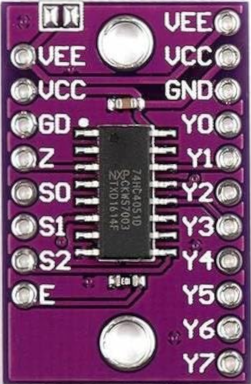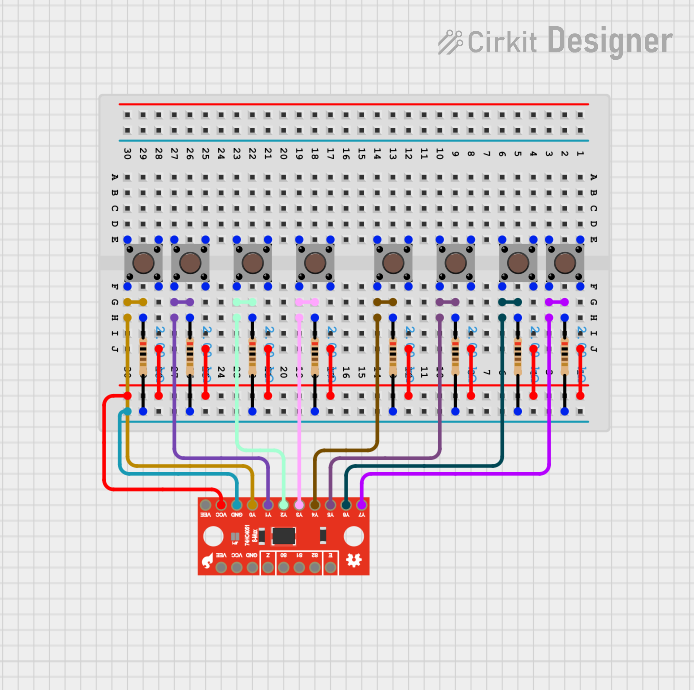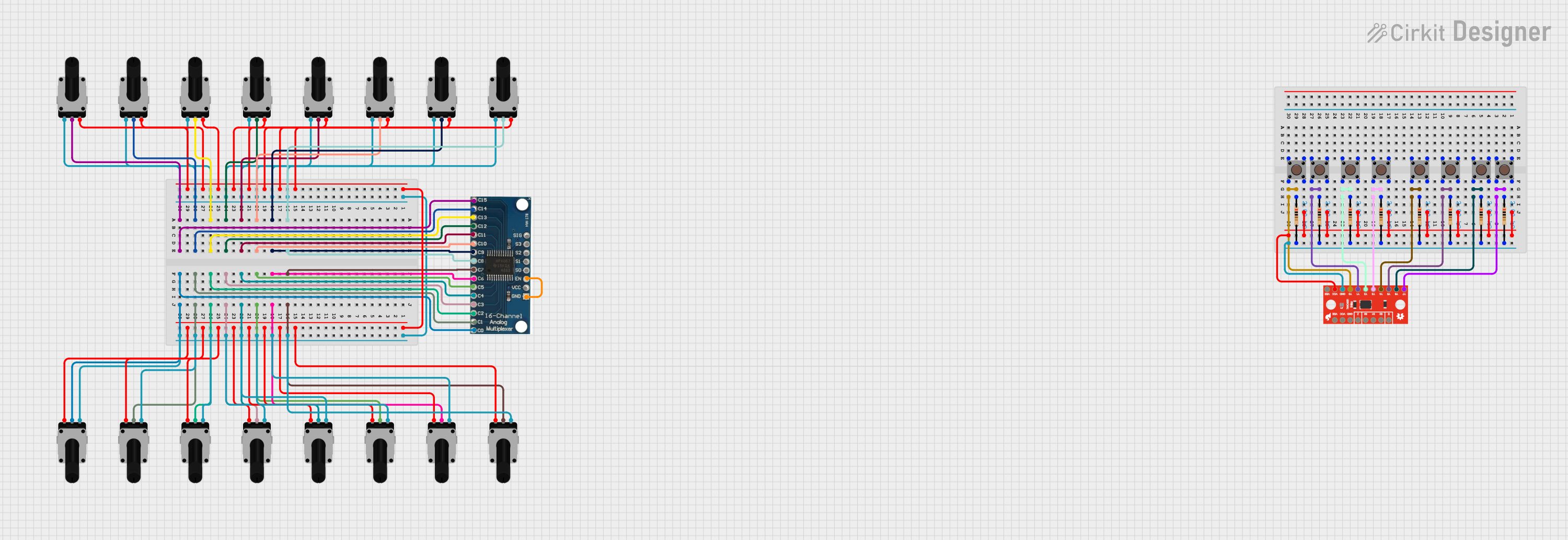
How to Use 74HC4051 CD4051 8-Channel Multiplexer: Examples, Pinouts, and Specs

 Design with 74HC4051 CD4051 8-Channel Multiplexer in Cirkit Designer
Design with 74HC4051 CD4051 8-Channel Multiplexer in Cirkit DesignerIntroduction
The 74HC4051 CD4051 is an 8-channel analog multiplexer/demultiplexer manufactured by Generic. It allows one of the eight input channels to be connected to a single output, or vice versa, enabling the selection and routing of multiple analog or digital signals. This component is widely used in signal switching, data acquisition systems, and microcontroller-based projects.
Explore Projects Built with 74HC4051 CD4051 8-Channel Multiplexer

 Open Project in Cirkit Designer
Open Project in Cirkit Designer
 Open Project in Cirkit Designer
Open Project in Cirkit Designer
 Open Project in Cirkit Designer
Open Project in Cirkit Designer
 Open Project in Cirkit Designer
Open Project in Cirkit DesignerExplore Projects Built with 74HC4051 CD4051 8-Channel Multiplexer

 Open Project in Cirkit Designer
Open Project in Cirkit Designer
 Open Project in Cirkit Designer
Open Project in Cirkit Designer
 Open Project in Cirkit Designer
Open Project in Cirkit Designer
 Open Project in Cirkit Designer
Open Project in Cirkit DesignerCommon Applications and Use Cases
- Signal routing in analog and digital systems
- Data acquisition in microcontroller projects
- Audio signal multiplexing
- Sensor selection in embedded systems
- Expanding the number of analog inputs for microcontrollers like Arduino
Technical Specifications
The following are the key technical details of the 74HC4051 CD4051:
| Parameter | Value |
|---|---|
| Supply Voltage (Vcc) | 2V to 10V (CD4051), 2V to 6V (74HC4051) |
| Control Voltage Range | 0V to Vcc |
| Analog Signal Range | 0V to Vcc |
| Maximum On-State Resistance | 70Ω (typical) |
| Maximum Switching Frequency | 6 MHz |
| Operating Temperature Range | -40°C to +85°C |
| Package Types | DIP-16, SOIC-16, TSSOP-16 |
Pin Configuration and Descriptions
The 74HC4051 CD4051 is a 16-pin IC. Below is the pinout and description:
| Pin Number | Pin Name | Description |
|---|---|---|
| 1 | E (Enable) | Active LOW enable pin. When HIGH, all channels are disconnected. |
| 2 | S1 | Select line 1 (used to select the active channel). |
| 3 | S2 | Select line 2 (used to select the active channel). |
| 4 | S3 | Select line 3 (used to select the active channel). |
| 5 | Z (Common I/O) | Common input/output pin for all channels. |
| 6 | Y7 | Channel 7 input/output. |
| 7 | Y6 | Channel 6 input/output. |
| 8 | VEE | Negative supply voltage (connect to GND for single-supply operation). |
| 9 | Y5 | Channel 5 input/output. |
| 10 | Y4 | Channel 4 input/output. |
| 11 | Y3 | Channel 3 input/output. |
| 12 | Y2 | Channel 2 input/output. |
| 13 | Y1 | Channel 1 input/output. |
| 14 | Y0 | Channel 0 input/output. |
| 15 | VCC | Positive supply voltage. |
| 16 | GND | Ground. |
Usage Instructions
How to Use the 74HC4051 CD4051 in a Circuit
- Power Supply: Connect the VCC pin to a positive voltage source (e.g., 5V for 74HC4051) and GND to ground. For single-supply operation, connect VEE to GND.
- Channel Selection: Use the S1, S2, and S3 pins to select one of the eight channels (Y0 to Y7). The binary combination of these pins determines the active channel:
- S3, S2, S1 = 000 → Y0 is connected to Z
- S3, S2, S1 = 001 → Y1 is connected to Z
- ...
- S3, S2, S1 = 111 → Y7 is connected to Z
- Enable Pin: Ensure the E pin is LOW to enable the multiplexer. If E is HIGH, all channels are disconnected.
- Signal Connection: Connect the input/output signals to the Y0–Y7 pins. The selected channel will route the signal to/from the Z pin.
Important Considerations and Best Practices
- Voltage Levels: Ensure that the input signal voltage does not exceed the supply voltage (VCC).
- Decoupling Capacitor: Place a 0.1 µF decoupling capacitor near the VCC pin to reduce noise.
- Unused Pins: Leave unused Y pins floating or connect them to GND through a pull-down resistor.
- Switching Speed: Avoid exceeding the maximum switching frequency to maintain signal integrity.
Example: Connecting to an Arduino UNO
The 74HC4051 can be used to expand the number of analog inputs for an Arduino UNO. Below is an example code to read from multiple analog sensors:
// Define control pins for the 74HC4051
const int S1 = 2; // Arduino pin connected to S1
const int S2 = 3; // Arduino pin connected to S2
const int S3 = 4; // Arduino pin connected to S3
const int Z = A0; // Arduino analog pin connected to Z
void setup() {
// Set control pins as outputs
pinMode(S1, OUTPUT);
pinMode(S2, OUTPUT);
pinMode(S3, OUTPUT);
// Initialize serial communication
Serial.begin(9600);
}
void loop() {
for (int channel = 0; channel < 8; channel++) {
// Set the select pins to choose the active channel
digitalWrite(S1, channel & 0x01); // Least significant bit
digitalWrite(S2, (channel >> 1) & 0x01); // Second bit
digitalWrite(S3, (channel >> 2) & 0x01); // Most significant bit
// Read the analog value from the selected channel
int value = analogRead(Z);
// Print the channel number and its value
Serial.print("Channel ");
Serial.print(channel);
Serial.print(": ");
Serial.println(value);
delay(500); // Wait for 500ms before reading the next channel
}
}
Troubleshooting and FAQs
Common Issues and Solutions
No Signal Output on Z Pin:
- Ensure the E pin is LOW to enable the multiplexer.
- Verify that the S1, S2, and S3 pins are set correctly to select the desired channel.
Signal Distortion or Noise:
- Check that the input signal voltage is within the range of 0V to VCC.
- Add a decoupling capacitor near the VCC pin to reduce power supply noise.
Incorrect Channel Selection:
- Double-check the binary combination of S1, S2, and S3 pins.
- Ensure the Arduino or microcontroller pins are configured as outputs.
High On-State Resistance:
- If the resistance is too high, ensure the supply voltage is within the recommended range (e.g., 5V for 74HC4051).
FAQs
Q: Can the 74HC4051 handle digital signals?
A: Yes, the 74HC4051 can handle both analog and digital signals, as long as the signal voltage is within the supply voltage range.
Q: Can I use the 74HC4051 with a 3.3V microcontroller?
A: Yes, the 74HC4051 is compatible with 3.3V systems. Ensure that VCC is set to 3.3V and the input signals do not exceed this voltage.
Q: What happens if the E pin is left floating?
A: If the E pin is left floating, its state may be undefined, leading to unpredictable behavior. Always connect it to GND (LOW) to enable the multiplexer or to VCC (HIGH) to disable it.